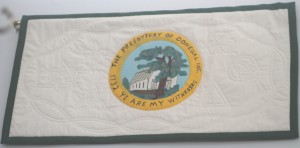By Bill Netting & Nathalie Clugston
With permission granted by the Synod of Philadelphia, the first meeting of the Presbytery of Donegal was held in the Donegal (church) Meeting House in Lancaster County on Oct. 11, 1732. At that time, Donegal was spelled “Dunagall.” (Later it was spelled “Donnegal,” “Donnegall” and finally “Donegal.”) A minister then was frequently referred to as “Mister” and often only by his last name. For at least its first 50 years, the business of the presbytery was largely devoted to the “appointment of ministers, rigorous examination of candidates and the hearing and acting upon complaints.”
 Donegal has undergone a number of structural and geographical changes during its 285 years of existence. Boundaries were often impossible to define because they were not spelled out in neat lines. This was further complicated by the fact that, at this time, the Presbytery of New Castle and the Presbytery of Donegal occupied the same geographical area but had jurisdiction over different congregations.
Donegal has undergone a number of structural and geographical changes during its 285 years of existence. Boundaries were often impossible to define because they were not spelled out in neat lines. This was further complicated by the fact that, at this time, the Presbytery of New Castle and the Presbytery of Donegal occupied the same geographical area but had jurisdiction over different congregations.
Also, at various times in the presbytery’s history, the Presbytery of Donegal completely ceased to exist as an entity. During those periods, its churches were members of Lancaster, Carlisle, Baltimore or New Castle Presbyteries. For a period of 63 years (from 1870-1932) the part of present presbytery (covering Lancaster County), in addition to Lebanon County, was known as the Presbytery of Westminster.
On June 27, 1957, the presbytery once again became the Presbytery of Donegal when Donegal and Chester Presbyteries united. It encompassed the three counties (Chester, Lancaster and York) west of Philadelphia. At that time there were 71 churches with a combined membership of over 26,000 people. In 2016, there were 49 churches with a membership of 15,000.
In an interesting footnote of the presbytery’s history, look back to 1741 when a bitter controversy arose. There was a group (known as “The Old Side”) that looked with disfavor upon the new revival movements of the “Great Awakening” (which stressed the experience of saving grace in the life of individual Christians) and it also held to the Synod’s requirement that candidates for ministry must have a degree from European or New England colleges and submit to examination by the Synod.
Another group (known as “The New Side”) favored revivalism and the use of untrained ministers to meet the growing need to establish new churches on the frontier. This controversy resulted in the division of the Synod into the Synod of Philadelphia and the Synod of New York and was so severe that it did not completely disappear even with the reunion of the synods in 1758. We note this to remind ourselves that the theological divisions that we experience in the 21st century are not new in our Presbyterian history.
As to leadership, the Rev. Dr. William J. Brown became the presbytery’s first Presbytery Executive in 1963. He has been followed by Rev. Dr. Donald Campbell, the Rev. Roger Uittenbogaard, the Rev. Charles Gross (Acting Executive – not installed), and the Rev. Dr. Erin Cox-Holmes, the present Executive.
